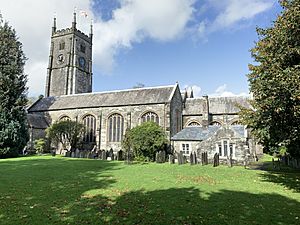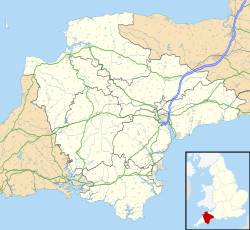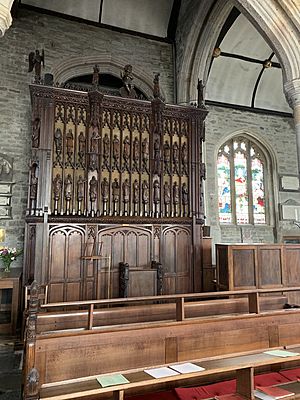St Eustachius' Church, Tavistock facts for kids
Quick facts for kids St Eustachius' Church, Tavistock |
|
|---|---|

St Eustachius' Church, Tavistock
|
|
| 50°32′58.7″N 4°8′40.1″W / 50.549639°N 4.144472°W | |
| OS grid reference | SX 48123 74431 |
| Location | 5A Plymouth Road, Tavistock, Devon PL19 8AU |
| Country | England |
| Denomination | Church of England |
| Previous denomination | Roman Catholic |
| History | |
| Dedication | Saint Eustace |
| Architecture | |
| Heritage designation | Grade II* listed |
| Designated | 7 September 1951 |
| Administration | |
| Parish | Tavistock |
| Deanery | Tavistock |
| Archdeaconry | Plymouth |
| Diocese | Exeter |
| Province | Canterbury |
St Eustachius' Church in Tavistock is a very old and important church. It is a Grade II* listed building, which means it is a special historical place. This church belongs to the Church of England and is located in Tavistock, Devon.
Contents
History of the Church Building
The church was first built a very long time ago, around the year 1193, or definitely by 1265. An important leader from Tavistock Abbey, named Abbot Robert Champeaux, rebuilt it in 1318. More building work happened in 1352 and 1380.
Most of the church was rebuilt in the 1400s. During this time, a new part called the chancel was added at the east end. A side section, known as the south aisle, was built between 1445 and 1447. This was paid for by a gift from Constance Coffyn.
Major Changes in the 1800s
The church had a big makeover between 1844 and 1845. An architect named John Hayward led this work. During this time, a new pulpit (a raised stand for sermons) made of Caen stone was added. New reading desks and carved pew ends were also put in. An old gallery was taken out. A new area for the organ was built in the north aisle, along with rooms for the clergy (vestries) south of the chancel. The church reopened for services on June 26, 1845.
In 1896, the font, which is a basin used for baptisms, was moved to the west end of the south aisle.
Restoration in the Early 1900s
Another restoration project took place between 1902 and 1903. The choir stalls, where the choir sits, were moved from the chancel. New marble flooring was put in. The main part of the church (nave) and its side aisles also got new floors. The roofs were repaired, and new figures of angels were put back in their original spots. New brass lights were hung from the roof, and the seating was rearranged. The work was done by J.A. Dennis of Tavistock, and the architect was George Fellowes Prynne.
A new reredos, which is a decorated screen behind the altar, was added in 1929. It had curtains called riddels and was designed by A.S. Parker. J.R. Hunt carved it, and it was officially dedicated on May 19, 1929.
Church Leaders (Vicars)
The church has had many vicars, who are like the main priests or ministers, over the centuries. Here is a list of some of the people who have served the church:
- 1309 Sir John de Cameleforde
- 1311 Sir John de Ockhampton
- 1318 Sir Robert Bodyer
- 1349 Richard de Bolham
- 1360 John, vicar of Boyton
- 1361 Baldwin Langdon
- 1382 David Bagatorre
- ???? Simon Tony
- 1391 John Hykedon, vicar of Landkey
- 1400 John Lucas
- 1416 Roger Sturt
- 1416 John Borneslo
- ???? John Baker
- 1427 Edmund Rawly
- 1434 William Mede
- 1439 John Kene
- 1443 John Skynner (or Shynner)
- 1460 Richard Haukeden
- ???? William Davy
- 1403 John Sargynt
- 1534 William Lawnder
- 1554 John Perins
- ???? Robert Knight
- 1584 Ralph Taylor
- 1585 Timothy Fisher
- 1587 Laurence Prychard
- 1592 Walter Ware
- 1600 Richard Adams
- 1603 John Ellistone
- 1612 Edward Elyott
- 1632 John Blythman
- ???? Tristram Cleake
- 1638 George Hughes
- 1649 Thomas Larkham
- 1661 Samuel Brown(e)
- 1662 Thomas Glanvil
- 1673 Jasper Cann
- 1690 William Hame
- 1697 John Rennell
- 1701 Nathaniel Beard
- 1731 William Brown
- 1747 Thomas Salmon
- 1758 John Jago
- 1796 Richard Sleman
- 1812 Edward Atkyns Bray
- 1857 Osborne John Tancock
- 1872 William John Tait
- 1883 Daniel Pring Alford
- 1895 Henry Godfrey Le Neveu
- 1918 Hugh Leslie Bickersteth
- 1946 Basil Tudor Guy
- 1956 George Hodgshon
- 1966 Roy Wyndham Stevenson
- 1973 Richard Gilpin
- 1992 John Rawlings
- 2007 Michael Brierley (priest in charge)
- 2015 Christopher Hardwick
- 2022 Matt Godfrey
The Church Organ
The first time an organ was mentioned in the church records was in 1538 or 1539. At that time, it needed repairs. By the 1790s, the church had a "barrel organ" in a gallery. This type of organ played music using a rotating barrel.
In 1802, the barrel organ was replaced. Then, in 1825, that organ was also replaced with a new one.
The organ you see in the church today was built by a company called J.W. Walker and Sons. It was first played by a famous musician named Samuel Sebastian Wesley on June 25, 1846.
The beautiful carved statues on the organ case were added in 1879. Later, other companies like Hele and Company and Lance Foy made changes and additions to the organ. Now, it is a large organ with three keyboards (manuals) and 51 different sounds (stops). You can find more details about this organ in the National Pipe Organ Register.
Organists of the Church
For a long time, the Duke of Bedford paid the organist's salary. However, by 1875, the salary had grown to £61 10s per year. The Duke decided it was time for the church members to pay for it themselves. At that time, the money from renting pews brought in £120 per year, while the church's running costs were £118 per year.
Here are some of the people who have been organists at St Eustachius' Church:
- Samuel Sebastian Wesley 1846
- John Frederick Thynne 1846 - 1877
- Alexander Luke Vingoe 1877 - 1878
- Charles John Vincent 1878 - 1883
- John Tomlinson 1883 - 1906
- William Clotworthy 1907 - 1942
- Harold Charles Lake 1942 - 1956
Church Bells
The church tower has a set of 10 bells that can be rung together. Eight of these bells were made in 1925 by John Taylor and Company of Loughborough. In 1998, two more new bells were added by the same company, making a total of 10 bells.



